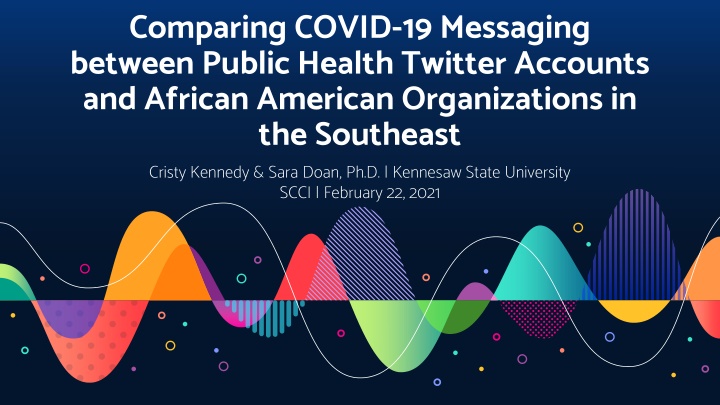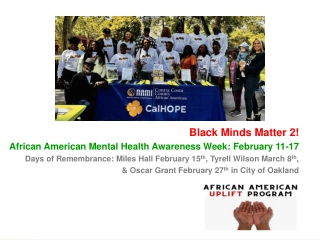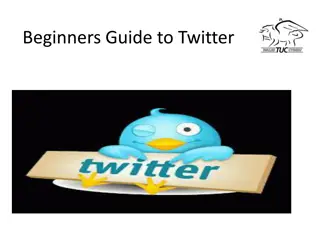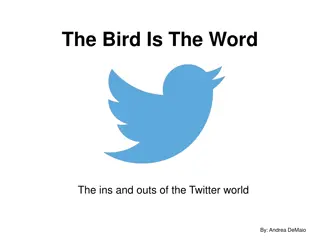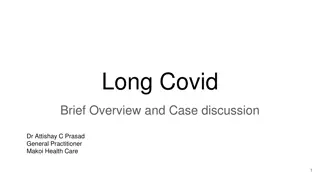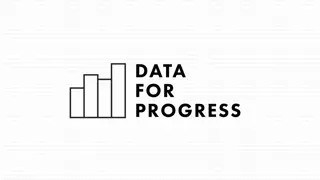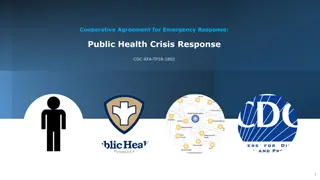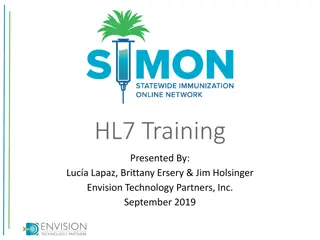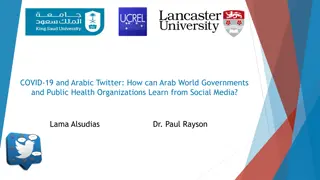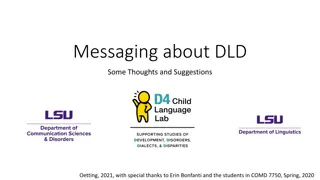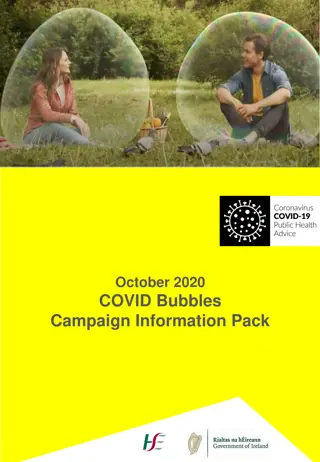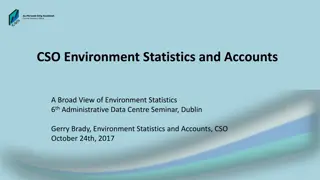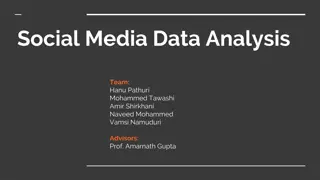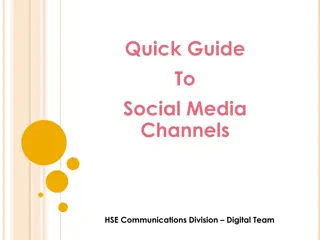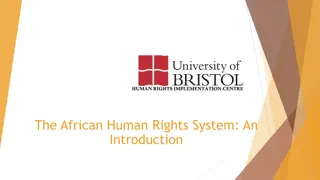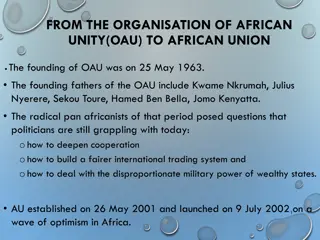Analyzing COVID-19 Messaging Among Public Health Twitter Accounts and African American Organizations
This study delves into the disparities in COVID-19 hospitalization rates among African Americans in the US and examines the messaging strategies employed by public health Twitter accounts and African American organizations in the Southeast. Research questions focus on the credibility and effectiveness of behavioral health messages related to COVID-19 and strategies for better serving and connecting with African American men aged 18-24. Data collection involved Twitter data analysis using specific keywords to categorize information from various health organizations.
Download Presentation

Please find below an Image/Link to download the presentation.
The content on the website is provided AS IS for your information and personal use only. It may not be sold, licensed, or shared on other websites without obtaining consent from the author.If you encounter any issues during the download, it is possible that the publisher has removed the file from their server.
You are allowed to download the files provided on this website for personal or commercial use, subject to the condition that they are used lawfully. All files are the property of their respective owners.
The content on the website is provided AS IS for your information and personal use only. It may not be sold, licensed, or shared on other websites without obtaining consent from the author.
E N D
Presentation Transcript
Comparing COVID-19 Messaging between Public Health Twitter Accounts and African American Organizations in the Southeast Cristy Kennedy & Sara Doan, Ph.D. | Kennesaw State University SCCI | February 22, 2021
During COVID-19, African Americans in the United States have seen hospitalization rates three times higher than the national average (Soucheray, 2020).
Situating Our Project African American communities information While Twitter has reach diverse audiences Walwema, 2020). Their communities have 19 19 (Gonz lez-Padilla & Tortolero-Blanco, 2020). African American communities rely heavily on social media information (Brown, 2019; Muvuka et al., 2020). While Twitter has potential to spread misinformation reach diverse audiences via state and public health organizations rely heavily on social media sites such as Twitter sites such as Twitter for health for health potential to spread misinformation about COVID via state and public health organizations (Hope, 2020; Kouzy et al., 2020; about COVID- -19, 19, it also has it also has potential potential to to Their communities have created personalized ecosystems created personalized ecosystems for information regarding for information regarding COVID COVID- -
Research Questions What behavioral health messages about COVID credible and effective? What changes can public health organizations implement when creating and distributing COVID health information to better serve and connect with African American men ages 18 What behavioral health messages about COVID- -19 do African American men credible and effective? What changes can public health organizations implement when creating and distributing COVID- -19 health information to better serve and connect with African American men ages 18- -24? 19 do African American men ages 18 ages 18- -24 find most 24 find most 19 24? 4
Data Collection Data from Twitter was collected using specific keywords and by searching the most frequently visited health organizations in GA, AL, and SC. African American health organizations were found using the keywords "Black," "African American," and "COVID Once data was collected it was categorized into three buckets; AA health organizations, public health organizations, and state health organizations. The data was then analyzed using NVivo 12 software. Data from Twitter was collected using specific keywords and by searching the most frequently visited health organizations in GA, AL, and SC. African American health organizations were found using the keywords "Black," "African American," and "COVID- -19." Once data was collected it was categorized into three buckets; AA health organizations, public health organizations, and state health organizations. The data was then analyzed using NVivo 12 software. 19."
Findings: Round 1 Coding African American health organizations on Twitter shared the common theme of misinformation communities. African American health organizations on Twitter shared the common theme of clarifying misinformation and false theories about COVID communities. clarifying and false theories about COVID- -19 that were circulating within Black 19 that were circulating within Black While public health organizations focused on focused on While public health organizations focused on prevention and spread focused on statistics and tips prevention and spread, state health organizations , state health organizations statistics and tips.. Although race organization and state health organizations Although race- -specific issues regarding COVID organizations, most accounts still used statistics from the CDC in the same manner as public and state health organizations.. specific issues regarding COVID- -19 were mentioned by African American health s, most accounts still used statistics from the CDC in the same manner as public 19 were mentioned by African American health
Example: COVID Black on Twitter Example: COVID Black on Twitter With over 4,000 followers on Twitter, @COVIDBLK has created a "personalized ecosystem" (Gonz lez-Padilla & Tortolero-Blanco, 2020) pertaining to COVID-19 in African American communities. @COVIDBLK emphasizes the importance of vaccine rollout, while sharing infographics and statistics from public health agencies such as the CDC. Users are constantly reminded that being young is not an effective form of disease prevention and that restaurants are still unsafe. @COVIDBLK compares the United States' COVID-19 progress to other countries, stressing the importance of intersectionality within health information.
Next Steps IRB approval for 3 focus groups with African American men on the KSU campus. Connecting with data Dr. Doan collected with two psychology professors. 8
Discussion Questions What health state Twitter What health contributions have state Twitter accounts could not have contributions have African American accounts could not have made? African American Twitter accounts made made? Twitter accounts made to their communities to their communities that that What criteria Southeast? What criteria would you use to Southeast? would you use to assess posts assess posts promoting promoting preventive health preventive health behaviors, especially behaviors, especially in the in the How can social small How can social media sites prevent small communities? media sites prevent future communities? future miscommunication miscommunication of health of health information even information even within within
References Brown, N. M. (2019). Methodological cyborg as black feminist technology: Constructing the social self using computational digital autoethnography and social media. Cultural Studies, Critical Methodologies, 19(1), 55 67. https://doi.org/10.1177/1532708617750178 Gonz lez-Padilla, D. A., & Tortolero-Blanco, L. (2020). Social media influence in the COVID-19 Pandemic. International Braz j Urol, 46(suppl 1), 120 124. https://doi.org/10.1590/s1677-5538.ibju.2020.s121 Hope, L. (2020). Protecting pandemic conversations: Tracing Twitter s evolving content policies during COVID-19. Journal of Business and Technical Communication, 105065192095839. https://doi.org/10.1177/1050651920958393 Kouzy, R., Abi Jaoude, J., Kraitem, A., El Alam, M. B., Karam, B., Adib, E., Zarka, J., Traboulsi, C., Akl, E., & Baddour, K. (2020). Coronavirus goes viral: Quantifying the COVID-19 misinformation epidemic on Twitter. Cureus. https://doi.org/10.7759/cureus.7255 Muvuka, B., Combs, R. M., Ayangeakaa, S. D., Ali, N. M., Wendel, M. L., & Jackson, T. (2020). Health literacy in African-American communities: Barriers and strategies. HLRP: Health Literacy Research and Practice, 4(3), e138 e143. https://doi.org/10.3928/24748307- 20200617-01
References cont.d Price-Haywood, E. G., Burton, J., Fort, D., & Seoane, L. (2020). Hospitalization and mortality among Black patients and white patients with Covid-19. New England Journal of Medicine, 382(26), 2534 2543. https://doi.org/10.1056/NEJMsa2011686 Soucheray, S. (2020, August 14). US blacks 3 times more likely than whites to get COVID-19. Center for Infectious Disease Research and Policy. https://www.cidrap.umn.edu/news-perspective/2020/08/us-blacks-3-times-more-likely-whites-get-covid-19 Walwema, J. (2020). The WHO Health Alert: Communicating a global pandemic with WhatsApp. Journal of Business and Technical Communication, 105065192095850. https://doi.org/10.1177/1050651920958507
